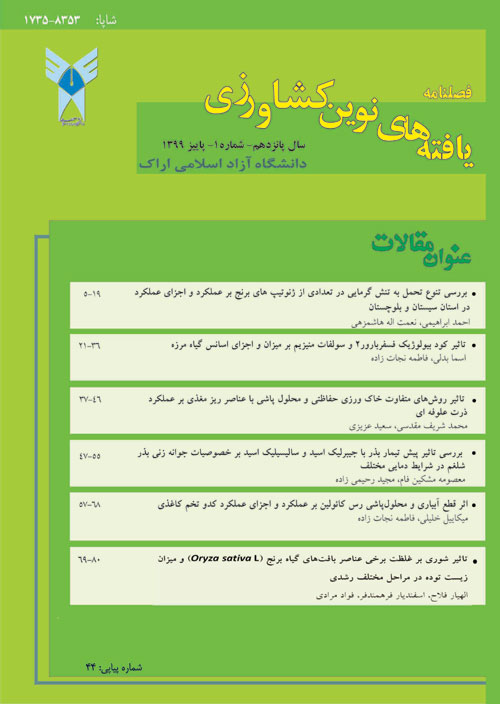The Study of Variation and Relationship between Quantitative and Qualitative Traits of Red Clover (Trifolium Pratense L.) in Climate Conditions of Borugerd
Author(s):
Abstract:
In order to study genetic variation and heritability in fifteen cultivars of red clover in climate conditions of Broujerd an experiment in based on randomized complete block design (RCBD) with three replications under irrigated conditions in Agriculture Researches Center and National Resources of Broujerd in 2013-2014 cropping year was carried out. The measured traits were including of dry and wet forage yield in three cuts, plant height, digestibility percentage, crude protein percentage (%CP),Water soluble carbohydrates (%WSC), insoluble fiber in acid percentage, crude fiber percentage (%CF) and ash percentage (%AH) in two cuts and ratio leaf to stem and regrowth rate in one cut. The qualitative traits were measured by near infrared reflectance (NIR) technology. The results of analysis of variance were indicated that differences between cuts for all traits and genotype effect and interaction genotype × cut for all traits except plant height and ash percentage were significant. Compare means, Duncan method were showed Chamran, Renova, Shahrecord and Reszti cultivars with range between 52 to 56 t.ha-1 wet forage and range of 17.3 to 18.3 t.ha-1 dry forage in general three cuts had the highest forage yield. In among them Renova and Shahrechord cultivars had the highest plant height and ratio leaf to stem, but Charmahal had high mean for qualitative traits including digestibility and total ash and low mean for ADF and %CP. low In other words, it had higher forage yield and quality. In comparison between means of cuts, the highest and lowest forage yield related to 1 and 3 cuts, respectively. Simple coefficients of correlation among forage yield with plant height and digestibility was positive and with ratio leaf to stem and soluble carbohydrates in water was negative and significant. Coefficients of correlation between digestibility and protein percentage were positive and significant and these traits had negative and significant correlation with soluble carbohydrates in water, percentage crude fiber and ADF. Results of principal components analysis (PCA) for 15 genotypes in 11 traits showed three first principal components explained 72% from total variation. In the first component, wet forage yield, digestibility percentage, crude protein percentage and soluble carbohydrate in water explained the highest variation. In the second component, plant height, insoluble fiber in acid, crude fiber percentage, total ash percentage had the highest vector coefficients. In the third component, dry forage yield with ratio leaf to stem had negative correlation. In cluster analysis base on the ward's method 15 genotypes of red clover for 11 traits placed in three clusters. Shahrod and Renova Cultivars placed in cluster number 3, and had high forage yield and medium digestibility percentage, crude protein percentage and soluble carbohydrates in water. In contrast, cultivars placed in cluster number 2, had medium yield but better quality. Cultivars placed in cluster number 1 had lower values for quantitative and qualitative traits.
Keywords:
Language:
Persian
Published:
Journal of New Finding in Agricultural, Volume:10 Issue: 3, 2016
Pages:
228 to 239
magiran.com/p1731226
دانلود و مطالعه متن این مقاله با یکی از روشهای زیر امکان پذیر است:
اشتراک شخصی
با عضویت و پرداخت آنلاین حق اشتراک یکساله به مبلغ 1,390,000ريال میتوانید 70 عنوان مطلب دانلود کنید!
اشتراک سازمانی
به کتابخانه دانشگاه یا محل کار خود پیشنهاد کنید تا اشتراک سازمانی این پایگاه را برای دسترسی نامحدود همه کاربران به متن مطالب تهیه نمایند!
توجه!
- حق عضویت دریافتی صرف حمایت از نشریات عضو و نگهداری، تکمیل و توسعه مگیران میشود.
- پرداخت حق اشتراک و دانلود مقالات اجازه بازنشر آن در سایر رسانههای چاپی و دیجیتال را به کاربر نمیدهد.
In order to view content subscription is required
Personal subscription
Subscribe magiran.com for 70 € euros via PayPal and download 70 articles during a year.
Organization subscription
Please contact us to subscribe your university or library for unlimited access!



